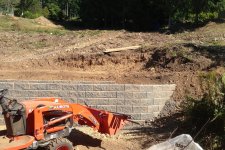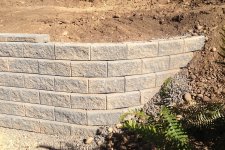Great views. A couple of things to keep in mind for the remainder of this first of many walls. I say the following having done my retaining wall twice now over a number of years, both times with assistance of landscaping contractors. I can't say what the spec is for your specific brand block, but the ones I used require anchoring them with a least one block's depth into the ground below grade. Since you are way too far along to do that now, you may want to consider driving some rebar deep into the ground in front of your bottom course to just at or slightly above grade and then cover same with plantings or more crushed stone so they remain invisible.
Don't know what your frost potential is in your area but if it is a real factor then I would want to make sure your drainage is excellent around the entire wall, sides, top and at each course.
I would start, since you have a hoe to use, as close to the hill next time. Dig along side where the wall is going to be placed and disturb as little of the hill material as possible. As you bury your first course and possibly more, depending on slope and wall height, to keep the wall from being able to kick out, make sure you use water to fill each block after placing your stone in it to help it settle out most fines and to allow you to fill the blocks if more stone is needed. I'd lay fabric over the stone used as backfill too so when you add soil fill it will not jam the stone with dirt.
As to the dilemma to how to tie sides into the bank, does your manufacturer sell curved blocks for this purpose?
Mine does and my blocks are held in by plastic pins which go into pre-formed holes and then the curved blocks can be rotated slightly to allow for gradually formed curves in any direction, like you see in one of the pics someone posted of their landscape wall.
I'm hoping for the best for you and this wall. Get the plate compactor. You're going to be glad you did. It is an essential tool for this work.
BTW I'd also run some drain tile directly out from the center of your next wall at the drain's level by adding a 't', so path of flow is that of least resistance.
These might give you a hint of why I just cleared some more of my slope in front of me and am building retaining walls!


